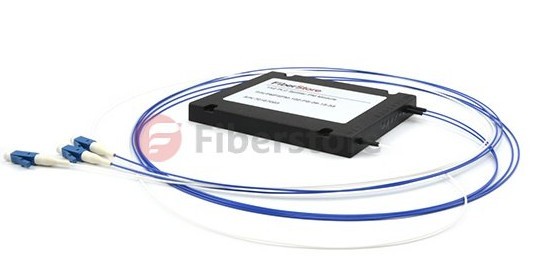Fiber optic splitter is used to split the fiber optic light into several parts at a certain ratio. For example, a 1×2 50:50 fiber optic splitter will split a fiber optic light beam into two parts, each get 50 percent of the original beam. Here the ratio is called splitting ratio. Fiber optic splitters can be terminated with different kinds of connectors, the main package could be box type or stainless tube type, one is usually used with 2mm or 3mm outer diameter cable, the other is usually used with 0.9mm outer diameter cables.
Fiber optic splitters are important passive components used in fiber optic communications. Nowadays two kinds of fiber splitters are very popular, one is the traditional fused type fiber optic splitter, which features competitive prices, the other is PLC splitter (as shown in the Figure),which is compact size and suit for density applications. Both of these two types fiber splitters has its advantages to suit for different requirement.
An optical splitter is a passive optical fiber tributary device that connects an optical line terminal to an optical network unit, such as PON splitter. It can transmit packets using time division multiplexing (TDM) in the downlink and gather packets using the time division multiplexing access (TDMA) protocol in the uplink.
Features:
Rack-Mounted Optical Splitter Unit Series
19-inch rack-mounted structure that supports ETSI-based installation;
Clearly identifies the connection and distribution of each optical core;
PC or APC (optional);
Standard rack-mounted structure that can be installed in an ODF or splice box for centralized management of large-scale fiber splitting;
Legible optical route identifiers for ease of future maintenance;
Sheet metal packaging for protecting optical components.
Case-Shape Optical Splitter unit-SPL1101 Serie
Optical splitting ratio ranging from 1:2 to 2:64;
Labeling clearly identifies the connection and distribution (assignments) for each optical core;
Adapter, PC, APC (optional).
Case-Shape Optical Splitter unit-SPL9101 Series
Split ratio ranging from 1:2 to 2:64;
Small-sized, general-purpose, and can be installed in a connector box, optical cross connection cabinet, or optical distribution box for fiber splitting;
Use fiber patch cords as input and output ends of the optical splitter unit.
Outdoor Wall-Mounted Optical Splitter Unit
High protection level;
Can be installed through a hole, on a pole, or in a trench with the help of auxiliaries;
Embedded with an optical splitter, fiber splicing device, fiber management tray, and fiber routing device.
Indoor Wall-Mounted Optical Splitter Unit
Can be mounted on a wall indoors;
Built-in optical splitter unit and cable distribution device for splitting and distributing fibers;
PC and APC (optional).
Applications & Benefits
With the split ratio ranging from 1:2 to 2:64, the optical splitter series can be installed in a connecting box, splice box, or optical division box for fiber splitting, while the clearly-labeled optical route identifiers facilitate easy maintenance.
Our splitter products are based on planar waveguide technology that offers maximum performance and exceptional long-term stability-ion-exchange in glass. The standard products are low-loss and broadband singlemode splitters for the entire telecommunications wavelength range manufactured on 6-inch wafers with splitting rates of 1×2 to 1×64, including splitters such as 1×5 or 1×12.
Fiberstore Fused Biconic Tapered splitter (FBT splitter) is available with 1×2, 1×3, 1×4, 1×5, 1×6, 1×8, 1×12, 1×16, 1×18, 1×20 and 1×24 configurations with single mode or multimode fiber. Our new multimode splitters are based on planar intergrated optical waveguides and are produced by means of ion exchange in glass. Thus, they are very compact, robust and long-term stable. Whether in sensor technologies or in optical power transfer, there is a wide range of applications. Planar waveguide components for the near infrared wavelength range are also available.

